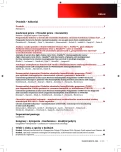Prognostic factors in chronic myeloid leukemia: can we gain more from combination?
Authors:
Z. Čermáková 1; J. Fürstová 2; T. Fürst 3; I. Marešová 4; I. Skoumalová 4; P. Rohoň 4; K. Indrák 4; T. Papajík 4; E. Faber 4
Authors‘ workplace:
Onkologická klinika FN Ostrava
1; 1. LF UK Praha
2; PřF UP v Olomouci
3; Hemato-onkologická klinika FN a LF UP v Olomouci
4
Published in:
Transfuze Hematol. dnes,22, 2016, No. 1, p. 6-13.
Category:
Comprehensive Reports, Original Papers, Case Reports
Overview
There are several prognostic scoring systems that are used for estimation of prognosis of patients with chronic myeloid leukaemia (CML) after the treatment with tyrosine kinase inhibitors (TKI) (EUTOS, Sokal and Hasford score). Individual patients may be allocated to different prognostic groups according various scores. It may be possible to improve the prognostication by the combination of these indices. The value of the new score was assessed in the group of 193 CML patients treated at Department of Haemato-Oncology in Olomouc between 1989 and 2013. Data collection and control was performed retrospectively. Method according Kaplan and Meier in combination with log-rank test was used for survival estimations. The group consisted of 77 females (39.9%) and 116 males (60.1%) at age 17–88 (median 54). Follow-up of the patients ranged from 3.6 to 296.6 months (median = 89.1). Seventy two (37.3%) patients were pretreated with interferon alfa for median of 9.33 months. Statistical analysis has confirmed good prognostic value of the Sokal and Hasford score for estimation of overall survival (OS) and progression-free survival (PFS). EUTOS score has not discriminated the good and poor risk patients with statistical significance in OS, for PFS it had the poorest performance. In order to count the new risk score the risk scores according to the Sokal and Hasford system were converted to the points (1 point for low, 2 points for intermediate and 3 points for high risk). The summary of points varied in individual patients between 2 and 6. The new score has improved the prognostic assessment of both OS and PFS. Adding EUTOS score to the combination has not improved the prediction significantly. The new score was better than existing indices also for the prognostic assessment of the patients not pretreated with interferon. Our statistical analysis showed that with the use of the simple combination of the existing scores (Sokal and Hasford) the prognostic assessment of CML patients may be improved. The results must be validated in larger groups of CML patients.
Key words:
chronic myeloid leukaemia – Hasford score – Sokal score – EUTOS score – prognosis – tyrosine kinase inhibitors
Sources
1. Nowell PC, Hungerford DA. A minute chromosome in human granulocytic leukemia. Science 1960; 132: 1497.
2. Rowley JD. A new consistent chromosomal abnormality in chronic myelogenous leukemia identified by quinacrine fluorescence and Giemsa staining. Nature 1973; 243: 290–293.
3. Björkholm M, Ohm L, Eloranta S, et al. Success story of targeted the-rapy in chronic myeloid leukemia: a population-based study of patients diagnosed in Sweden from 1973 to 2008. J Clin Oncol 2011; 29: 2514–20.
4. Baccarani M, Deininger MW, Rosti G, et al. European LeukemiaNet recommendations for the management of chronic myeloid leukemia: 2013. Blood 2013; 122: 872–884.
5. Sokal JE, Cox EB, Baccarani M, et al. Prognostic discrimination in “good-risk” chronic granulocytic leukemia. Blood 1984; 63: 789–799.
6. Hasford J, Pfirrmann M, Hehlmann R, et al. A new prognostic score for the survival of patients with chronic myeloid leukemia. J Natl Cancer Inst 1998; 90: 850.
7. Hasford J, Baccarani M, Hoffmann V, et al. Predicting complete cytogenetic response and subsequent progression-free survival in 2060 patients with CML on imatinib treatment: the EUTOS score. Blood 2011; 118: 686–692.
8. Marin D, Amr R, Ibrahim AR, Goldman JM. European Treatment and Outcome Study (EUTOS) score for chronic myeloid leukemia still requires more confirmation. J Clin Oncol 2011; 29: 3944–3945.
9. Jabbour E, Cortes J, Nazha A, et al. EUTOS score is not predictive for survival and outcome in patients with early chronic phase chronic myeloid leukemia treated with tyrosine kinase inhibitors: a single institution experience. Blood 2012; 119: 4524–4526.
10. Harrell FE, Lee KL, Mark DB. Tutorial in biostatistics. Stat Med 1996;15:361–387.
11. Tura S, Baccarani M, Corbelli G, et al. Staging of chronic myeloid leukaemia. Br J Haematol 1981; 47: 105–119.
12. Cervantes F, Rozman C. A multivariate analysis of prognostic factors in chronic myeloid leukemia. Blood 1982; 60: 1298–1304.
13. Kantarjian HM, Keating MJ, Smith TL, et al. Proposal for a simple synthesis prognostic staging system in chronic myelogenous leukemia. Am J Med 1990; 88: 1–8.
14. Hoffmann VS, Baccarani M, Lindoerfer D, et al. The EUTOS prognostic score: review and validation in 1288 patients with CML treated frontline with imatinib. Leukemia 2013; 27: 2016–2022.
15. Yahng SA, Jang EJ, Choi SY, Lee SE, Kim SH, Kim DW. Prognostic discrimination for early chronic phase chronic myeloid leukemia in imatinib era: comparison of Sokal, Euro, and EUTOS scores in Korean population. Int J Hematol 2014; 100: 132–140.
16. Rohoň P, Rožmanová Š, Zapletalová J, et al. Výsledky liečby pacientov v chronickej fáze chronickej myelocytovej leukémie na HOK v Olomouci v rokoch 2000–2009: prognostický význam Sokalovho indexu a ELN kritérií. Transfuze Hematol dnes 2010; 16(4): 202–209.
Labels
Haematology Internal medicine Clinical oncologyArticle was published in
Transfusion and Haematology Today

2016 Issue 1
Most read in this issue
- Prognostic factors in chronic myeloid leukemia: can we gain more from combination?
- Chronic myeloid leukaemia – standardization of BCR-ABL1 transcript level monitoring in the Czech Republic
- Consensual guidelines of the Czech National Haemophilia Programme (CNHP) for factor replacement therapy in patients with haemophilia during invasive procedures and surgery
- Autologous stem cell transplantation in Waldenström macroglobulinemia
